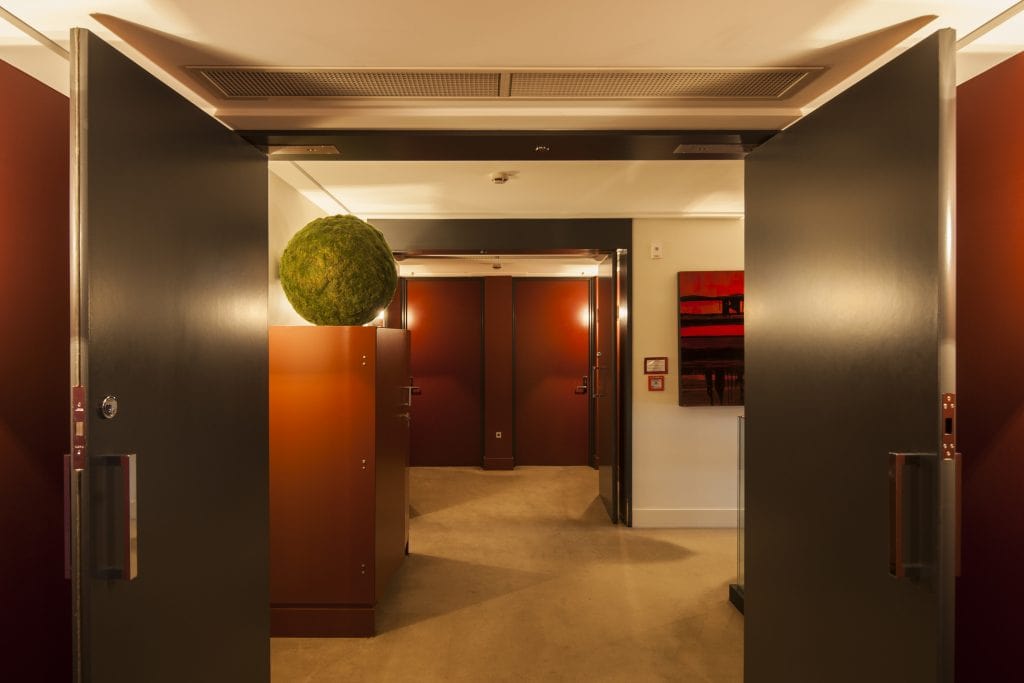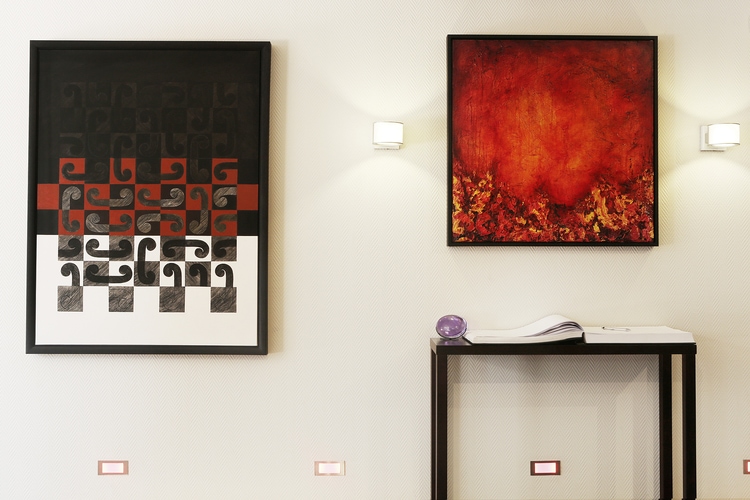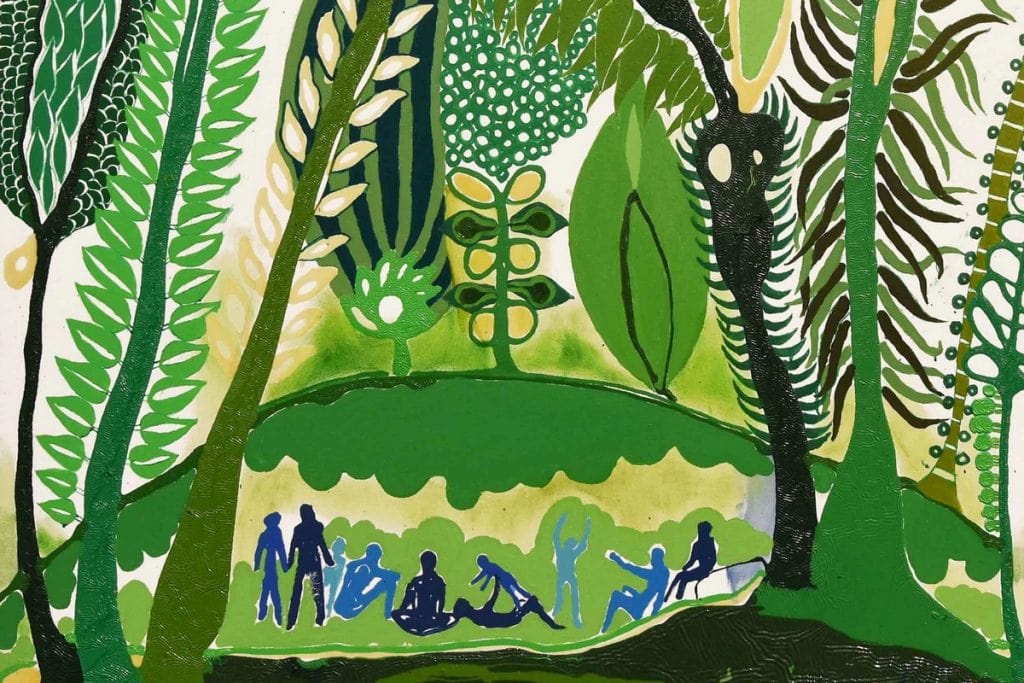Purposefully designed, The Spire Hotel’s interior celebrates the evolution of art in the city, offering our manuhiri an immersive cultural experience during their stay. Our main areas and rooms have been transformed into exhibition spaces, with art chosen to enhance our contemporary aesthetic.
The Spire proudly displays an array of Maori and Pacific Islander artwork, recognising artists who have made significant contributions to art and education in New Zealand. These pieces reflect our dedication to cultural preservation, showcasing our incredible Whenua and surrounding island communities.
Moana Nepia
Gracing the hotel lobby, The Spire’s most popular piece of art is a stunning feather work by New Zealand artist Moana Nepia. Nepia’s body of work is reflective of a life rich in experience, learning and cultural immersion, and his colourful portfolio extends far beyond visual art. A former classical ballet and contemporary dancer in New Zealand and Europe, he also trained and graduated as a painter from Chelsea and Wimbledon Schools of Art in London, and worked as an Assistant Professor at the Center for Pacific Islands Studies at the University of Hawai’i and Arts Editor for The Contemporary Pacific Journal. Nepia’s creative work, both written and visual, has been exhibited worldwide, and The Spire is proud to showcase Multicoloured Squares Within Squares (2002) with prominence in our most frequented hotel space. The 2002 piece is a fusion of dyed and natural feathers, used to create a huge, kaleidoscope of colours and textures that invite closer inspection. The concept is a convergence of cultural influence and aesthetic, using the feathers to add a natural, soft movement to the piece that is reminiscent of Maori heritage.
John Pule
John Pule has been described as one of the Pacific Island’s most significant and celebrated artists, and The Spire proudly displays six pieces of his work throughout the hotel and guest rooms. Born in Niue, an island northeast of New Zealand and one of the smallest countries on earth, Pule emigrated with his family to New Zealand at the age of two. When he first began to paint as a young adult in the 1980s, principles of poetry and painting were foreign concepts and no formal art school education had been undertaken. Largely self-taught and drawing from his own experiences and personal identity, Pule has channelled his talent into the creation of highly inventive, challenging and provocative art, inspired by the world he grew up in. His art is steeped in mythologies and history, considering colonisation, Christianity and migrant cultures. The work featured throughout The Spire is compelling, laden in striking tones, patterns and symbols that invite deeper reflection.
Filipe Tohi
Paying homage to island culture and his heritage, Filipe Tohi is a tufuga lalava – an expert in the Tongan art of binding with coconut sennit. Lalava was the Pan-Pacific technology employed on houses, canoes and tools before the later introduction of Western materials. Tongan born, Tohi immigrated to New Zealand in 1978 where he later educated himself in the traditional art of lalava before reintroducing the practice to other parts of the Pacific. Tohi’s commitment to mastering this craft is an ode to his Pacific island heritage and over the course of his career, has become a way to understand the patterns and language hidden inside the layers of sennit. Speaking of his work and knowledge of lalava, Tohi describes a communication of cultural knowledge and history, as well as the conveyance of memories and experiences across the Pacific. Tohi continues to create and educate, instructing students and showcasing his work through exhibitions around the world, including three pieces in The Spire Hotel.
Sandy Adsett
More than five decades on, Sandy Adsett is still as passionate about Maori arts as he was when he first became involved in the 1950s. Adsett’s journey to Maori art specialisation grew from his education at Te Aute Boys College in Hawkes Bay, progressing to formal art training at Ardmore and Dunedin teachers colleges. In the 1960s, he became an arts specialist for the Department of Education’s Advisory Service and was a driving force behind the introduction of the Maori Arts in Schools program. He continued his work in the education sector of arts and program development, eventually setting up the Toimairangi School of Maori Visual Culture within Te Wananaga o Aotearoa. In 2005, Adsett received the Order of New Zealand for Service to Art and Te Wananga o Aotearoa cited him as adjunct professor for his contribution to art education and the Maori community. Adsett’s striking piece Te Koru (2003) is displayed with distinction in The Spire’s reception area, depicting the koru motif, an important symbol in Maori culture.
Vanessa Edwards
Of Maori and European descent, Vanessa Edwards uses art as a form of self-expression and exploration, examining her own heritage by combining the customs of Maori weaving and European printmaking. The crossover of two longstanding traditions sees Edwards work in etching and drypoint, creating lines and tones in which to push and pull ink in and out. As Edwards crafts her art, she is reflective of traditional practices like ceremonial weaving and explores the sustainability of these practices in a new context. After completing her Bachelor of Arts in 2002, Edwards moved onto studying the Maori language at Te Wananga o Aotearoa. She continues to create pieces at her Wanganui studio




